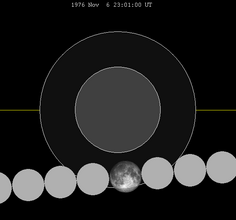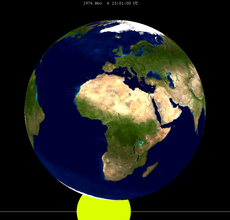
A penumbral lunar eclipse took place on April 24, 2005, the first of two lunar eclipses in 2005. At maximum eclipse, 86.5% of the Moon's disc was partially shaded by the Earth, which caused a slight shadow gradient across its disc; this subtle effect may have been visible to careful observers. No part of the Moon was in complete shadow. The eclipse lasted 4 hours and 6 minutes overall, and was visible from east Asia, Australia, and the Americas.

A partial lunar eclipse was visible on 31 December 2009. It was the last and largest of four minor lunar eclipses in 2009. This lunar eclipse was also notable, because it occurred during a blue moon and was near perigee. The next eclipse on New Year's Eve and blue moon will occur on 31 December 2028.
A penumbral lunar eclipse took place on 23 March 2016, the first of three lunar eclipses in 2016. The Moon was just 2.1 days before apogee, making it very small, so this was a "Micromoon" penumbral lunar eclipse.

A partial lunar eclipse took place at the Moon's descending node on the evening of 7 August and the morning pre-dawn on 8 August 2017, the second of two lunar eclipses in 2017. The Moon was only slightly covered by the Earth's umbral shadow at maximum eclipse. The Moon's apparent diameter was smaller because the eclipse occurred only 5 days after apogee.
A penumbral lunar eclipse took place on Thursday, March 3, 1988, the first of two lunar eclipses in 1988, the second being on August 27, 1988. Earlier sources compute this as a 0.3% partial eclipse lasting under 14 minutes, and newest calculations list it as a penumbral eclipse that never enters the umbral shadow. In a rare total penumbral eclipse, the entire Moon was partially shaded by the Earth, and the shading across the Moon should have been quite visible at maximum eclipse. The penumbral phase lasted for 4 hours, 53 minutes and 50.6 seconds in all, though for most of it, the eclipse was extremely difficult or impossible to see. The Moon was 2.2 days after apogee, making it 6.1% smaller than average.
A penumbral lunar eclipse took place on Tuesday, April 14, 1987, the first of two lunar eclipses in 1987, the second being on October 7, 1987. This subtle penumbral eclipse may have been visible to a skilled observer at maximum eclipse. 77.703% of the Moon's disc was partially shaded by the Earth, which caused a gentle shadow gradient across its disc at maximum; the eclipse as a whole lasted 3 hours, 54 minutes and 12.8 seconds. The Moon was just 4.6 days before perigee, making it 0.5% larger than average.
A penumbral lunar eclipse took place on Thursday, November 8, 1984, the last of three lunar eclipses in 1984. This subtle penumbral eclipse may have been visible to a skilled observer at maximum eclipse. 90% of the Moon's disc was partially shaded by the Earth, which caused a gentle shadow gradient across its disc at maximum; the eclipse as a whole lasted 4 hours and 28 minutes.
A penumbral lunar eclipse took place on Tuesday, December 20, 1983, the second of two lunar eclipses in 1983. At the maximum eclipse, 89% of the Moon's disk was partially shaded by the Earth, which caused a slight shadow gradient across its disc; this subtle effect may have been visible to careful observers. No part of the Moon was in complete shadow. The eclipse lasted 4 hours and 2 minutes overall.
A penumbral lunar eclipse took place on Tuesday, January 20, 1981, the first of two lunar eclipses in 1981. In a rare total penumbral eclipse, the entire Moon was partially shaded by the Earth, and the shading across the Moon should have been quite visible at maximum eclipse. The penumbral phase lasted for 4 hours and 24 minutes in all, though for most of it, the eclipse was extremely difficult or impossible to see. The moon's apparent diameter was larger because the eclipse occurred 5.2 days after perigee.
A penumbral lunar eclipse took place on Sunday, July 27, 1980, the second of three penumbral lunar eclipses in 1980. This very subtle penumbral eclipse was essentially invisible to the naked eye; though it lasted 2 hours, 17 minutes and 36.3 seconds, just 25.354% of the Moon's disc was in partial shadow. The moon passed in the northern edge of the Earth's penumbral shadow, and was the 70th lunar eclipse of Saros cycle 109.
A penumbral lunar eclipse took place on Tuesday, September 27, 1977, the second of two lunar eclipses in 1977. At maximum eclipse, 90.076% of the Moon's disc was partially shaded by the Earth, which caused a slight shadow gradient across its disc; this subtle effect may have been visible to careful observers. No part of the Moon was in complete shadow. The eclipse lasted 4 hours, 17 minutes and 35.5 seconds overall. Occurring 6.2 days before apogee, the Moon's apparent diameter was 2.2% smaller than average.
A penumbral lunar eclipse took place on Saturday, March 1, 1980, the first of three penumbral lunar eclipses in 1980. This subtle penumbral eclipse may have been visible to a skilled observer at maximum eclipse. 65.455% of the Moon's disc was partially shaded by the Earth, which caused a gentle shadow gradient across its disc at maximum; the eclipse as a whole lasted 3 hours, 58 minutes and 33.3 seconds.
A penumbral lunar eclipse took place at the Moon's descending node of the orbit on Tuesday, August 26, 1980, the last of three penumbral lunar eclipses in 1980 with a penumbral magnitude of 0.70891. This subtle penumbral eclipse may have been visible to a skilled observer at maximum eclipse. 70.891% of the Moon's disc was partially shaded by the Earth, which caused a gentle shadow gradient across its disc at maximum; the eclipse as a whole lasted 3 hours, 34 minutes and 26 seconds.
A partial lunar eclipse took place on Thursday, May 13, 1976, the first of two lunar eclipses in 1976, the second being a penumbral lunar eclipse on November 6, 1976. At maximum eclipse, a small bite out of the Moon should have been visible. The eclipse lasted for 1 hour, 15 minutes and 23.8 seconds, with just 12.17% of the Moon in shadow at maximum. Occurring only 1.1 days after perigee, the Moon's apparent diameter 5.4% larger than average.
A partial lunar eclipse took place on Saturday, February 21, 1970. It was the first of two partial lunar eclipses in 1970, the other being on August 17 of the same year. A tiny bite out of the Moon may have been visible at maximum, though just 5% of the Moon was shadowed in a partial eclipse which lasted for 52 minutes and 42 seconds. A shading across the moon from the Earth's penumbral shadow should have been visible at maximum eclipse.
A penumbral lunar eclipse took place on Wednesday, April 2, 1969, the first of three penumbral lunar eclipses in 1969, the second being on Wednesday, August 27, and the last being on Thursday, September 25. This subtle penumbral eclipse may have been visible to a skilled observer at maximum eclipse. 70.337% of the Moon's disc was partially shaded by the Earth, which caused a gentle shadow gradient across its disc at maximum; the eclipse as a whole lasted 3 hours, 43 minutes and 46.9 seconds. Occurring only 4.2 days before perigee, the Moon's apparent diameter was 0.9% larger than average.

A penumbral lunar eclipse took place on Thursday, September 25, 1969, the last of three penumbral lunar eclipses in 1969, the first being on Wednesday, April 2, and the second being on Wednesday, August 27. At maximum eclipse, 90% of the Moon's disc was partially shaded by the Earth, which caused a slight shadow gradient across its disc; this subtle effect may have been visible to careful observers. No part of the Moon was in complete shadow. The eclipse lasted 4 hours and 5 minutes overall.

A partial lunar eclipse took place on Saturday, July 6, 1963 with an umbral eclipse magnitude of 0.70602. The Moon was strikingly shadowed in this deep partial eclipse which lasted 3 hours exactly, with 71% of the Moon in darkness at maximum. A partial lunar eclipse occurs when the Earth moves between the Sun and Moon but the three celestial bodies do not form a straight line in space. When that happens, a small part of the Moon's surface is covered by the darkest, central part of the Earth's shadow, called the umbra. The rest of the Moon is covered by the outer part of the Earth's shadow called the penumbra. It was the second of three lunar eclipses in 1963, the first was a penumbral lunar eclipse on January 9, 1963 and the third and last was on December 30, 1963.

A penumbral lunar eclipse took place on Wednesday, December 8, 1965. At maximum eclipse, 88% of the Moon's disc was partially shaded by the Earth, which caused a slight shadow gradient across its disc; this subtle effect may have been visible to careful observers. No part of the Moon was in complete shadow. The eclipse lasted 4 hours and 1 minute overall.

A penumbral lunar eclipse took place at the Moon's ascending of the orbit on Sunday, June 5, 1955, with a penumbral eclipse magnitude of 0.62181 (62.181%). A penumbral lunar eclipse takes place when the Moon moves through the faint, outer part of Earth's shadow, the penumbra. This type of eclipse is not as dramatic as other types of lunar eclipses and is often mistaken for a regular Full Moon. The Moon shines because its surface reflects the Sun's rays. A lunar eclipse happens when the Earth comes between the Sun and the Moon and blocks some or all of the Sun's light from reaching the Moon. A penumbral lunar eclipse occurs when the Sun, Earth, and the Moon are imperfectly aligned. When this happens, the Earth blocks some of the Sun's light from directly reaching the Moon's surface and covers all or part of the Moon with the outer part of its shadow, also known as the penumbra. Since the penumbra is much fainter than the dark core of the Earth's shadow, the umbra, a penumbral eclipse of the Moon is often difficult to tell apart from a normal Full Moon. Occurring only 0.5 days after apogee, the moon's apparent diameter was 6.5% smaller than average.


























